You also want an ePaper? Increase the reach of your titles
YUMPU automatically turns print PDFs into web optimized ePapers that Google loves.
The <strong>sense</strong> of touch<br />
– it’s all over the skin<br />
We become aware of the versatility of our tactile<br />
<strong>sense</strong> when we think of such diverse experiences<br />
as caressing, fondling, itching, nibbling, tickling,<br />
scratching, and kissing. Or consider some special<br />
situations like jumping into a cold pool on a hot<br />
summer day, withdrawing your foot from a muddy<br />
patch, or the crunching of wet sand between<br />
your toes. People who are deaf and blind demonstrate<br />
that it is possible to orientate themselves<br />
by their <strong>sense</strong> of touch. If we had no tactile<br />
<strong>sense</strong>, it would have been like living in vague,<br />
dull surroundings where one could lose a leg or<br />
burn one’s skin, or get disorientated without even<br />
noticing it.<br />
There are many metaphors in our language which<br />
refer to touching and feeling. <strong>Our</strong> emotions are<br />
called feelings, and when we are moved, we say<br />
that something has touched us. Problems can be<br />
“ticklish” or “tough”. Some people have to be<br />
handled “with kid gloves”. Music teachers chide<br />
their pupils for not having enough “feeling in<br />
their fingertips”, meaning that a difficult-to-describe<br />
“something” is lacking in their performance.<br />
The physiological term for the transmission of<br />
information by means of receptors (Latin receptor<br />
= recorder) is sensibility (Latin sensibilis =<br />
observable). A receptor is the end of a nerve fibre,<br />
or a specialised cell, which can detect stimuli and<br />
convert them into neural impulses.<br />
General sensibility: Tremendous amounts of<br />
information are detected by receptors and are<br />
subsequently processed in the central nervous<br />
system. This complex process is known as sensibility.<br />
The receptors are located in the skin, in<br />
structures like muscles and skeletal joints, or in<br />
internal <strong>organs</strong>, and are respectively known as<br />
superficial, deep, and visceral sensibility (Latin<br />
viscera = intestine). As distinct from the other<br />
four <strong>sense</strong>s (hearing, seeing, smelling and tasting),<br />
these three types are known collectively as<br />
somato-visceral sensibility. Only a small fraction<br />
of all these signals are consciously perceived.<br />
Several kinds of receptors can be distinguished<br />
according to the stimuli which they detect,<br />
namely mechanical, thermal, chemical, osmotic,<br />
and polymodal receptors. The latter refer to more<br />
than one type of stimulus.<br />
Sensibility of the skin: We will here restrict<br />
ourselves to superficial sensibility, namely the<br />
perceptions mediated by the skin (cutis). This is<br />
a (nearly) watertight covering which protects all<br />
body tissues from physical damage. At the same<br />
time the skin is a highly sensitive <strong>sense</strong> organ<br />
which can simultaneously detect various stimuli<br />
that can be quite independent of one another.<br />
A large number of different sensations can be<br />
perceived via the skin: the softness of a cat’s fur,<br />
the roughness of a masonry wall, the smoothness<br />
of ice, the pleasant warm sensation of a<br />
sauna, but also the thorns of a rosebush, or the<br />
burning pain of a fresh wound. Strong emotions<br />
can be aroused through the skin, as by a passionate<br />
kiss or tender caresses. Many properties of<br />
objects cannot be appraised by hearing, seeing,<br />
or smelling, but only by touch, as for example,<br />
weight, temperature, hardness, roughness, dampness,<br />
stickiness, and elasticity. We recognise surface<br />
structures and shapes by touch.<br />
There are very many sensitive points in the skin,<br />
but they are not evenly distributed. They are closer<br />
together on face and hands than, for example,<br />
on the back, which is therefore less sensitive.<br />
There are three independent skin <strong>sense</strong>s, namely<br />
touch, temperature, and pain.<br />
Not only do we have unique fingerprints, the<br />
patterns of our skin pores are also unique. The<br />
skin is a dual-layered membrane. The inner,<br />
spongy, leathery layer has a thickness of between<br />
one and two millimetres. It consists essentially of<br />
connective tissue which is rich in the protein collagen.<br />
It protects and cushions the body, and it<br />
contains hair follicles, nerve ends, and sweat-<br />
39
















